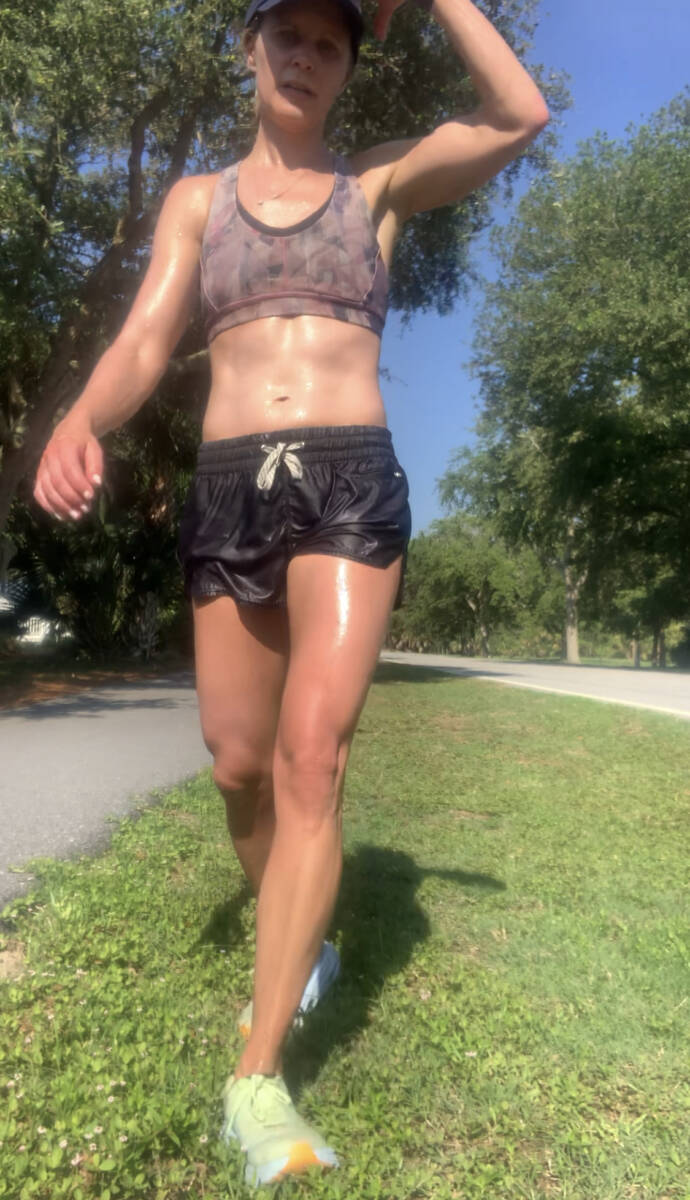The best way to get used to running in the heat is to not avoid it. The more you run in hot weather, the more physiological changes your body will undergo to adapt. These changes will make you a faster running in cool weather, so it is worth the discomfort. Learn more on how to adapt to running in the heat below!

We all know it—the first day that spring decides to give us a preview and we can’t wait to run—only to feel totally heavy and lethargic because our bodies aren’t used to running in the heat.
At the first sign of running in hot weather, many head for the mills (as in treadmills—see what I did there…). But then you miss out on running in beautiful sunny weather. And you miss out on the performance boost training in heat can give you.
Related: How to Make Running in Humidity Easier
Listen up, mamas!: Acclimating to the heat doesn’t take long. Your body is smart! And there are ways to speed up the process.
Table of contents
- Is it harder to run when it’s hot?
- Is it better to run in heat or humidity?
- How do you adapt to running in hot weather?
- Do you run slower in the heat?
- Is it harder to run in the heat as a woman?
- Can you adjust to running in the heat?
- How long does it take to adjust to running in the heat?
- 3 Steps to Adjust to Running in the Heat
Related: Smart Treadmill Running Tips for Mother Runners
Is it harder to run when it’s hot?
Yes, it is harder to run when it’s hot because your body is working harder to keep you cool. Basically, it’s prioritizing keeping you alive over helping you run fast.
Specifically, your body is:
- Using blood to carry away heat by pumping to the skin instead of to your muscles which means your muscles have less oxygen to work with;
- As a result, blood volume decreases (along with VO2 max) and becomes viscous, making it harder to move, so your heart pumps harder (even while running at a slow pace);
- Your body is also sweating, trying to keep your core temperature down;
- This extra work requires more carbs, so your body burns through fuel faster;
- This then leads to higher pyruvate production which leads to more lactate formation which leads to fatigue settling in sooner;
- There’s also more muscle damage since the muscles don’t have the usual amount of oxygen it needs to recover.
Because of this: it’s estimated that for every 10-degree increase in temperature about 55 degrees, there is a 1.5 to 3 percent increase in the average marathon finishing time. (Thus, the faster marathon time you have, the lower the increase). Ooof…
The good news is the more exposure to running in the heat, the more efficient your body will become at regulating its core temperature and keeping blood flowing to your muscles. This happens as the decreased amount of oxygen to the kidneys signals a release of the hormone EPO which signals the production of more red blood cells to carry more oxygen throughout the body.
When this process begins to happen, running starts to feel easier.
Related: Benefits of an Easy Running Pace

Is it better to run in heat or humidity?
Running in heat or humidity is taxing on the body with humidity being potentially more stressful. This is because as your body tries to cool itself through sweating, the moisture in the air keeps the sweat from evaporating (integral to cooling).
The body responds by sweating more, using water from the blood, which makes your blood thicker, which makes it harder to move, which causes your heart to pump harder, which uses more glycogen, which causes fatigue sooner.
Running in heat and humidity is extremely taxing on the body—and it’s best to keep runs in high heat and humidity days easy (and short!).
Related: 9 Running Hacks that Will Make You Run Faster
How do you adapt to running in hot weather?
You can adapt to running in hot weather by not avoiding it. Embrace the heat. Get outside and run in warm temperatures (but not blazing) every day for at least 30 minutes.
After just three days, your body will begin to start making physiological changes to become more efficient at running in hot weather including:
- A decreased heart rate
- Increased blood plasma volume
- Decreased renal sodium concentration, and
- Decreased perceived exertion
Do you run slower in the heat?
Yes, you run slower in the heat. Most studies find that the 59-degree mark is when temperature negatively impacts running performance.
This is because your body is busy trying to keep the core temperature down, thereby diverting oxygen-rich blood (needed for energy production) to your skin away from working muscles. Your muscles need oxygen to convert glucose into ATP to provide your body with the energy it needs to keep running.
So how much slower do you run in the heat? It depends on how fast you are running. Studies show that:
- Runners running a 5:45 pace or faster slowed 1 second per mile for each 1.8-degree rise in temperature above 59 degrees.
- Runners running an average of 7:25 to 10-minute miles slowed their pace between 4 and 4.5 seconds per mile for each 1.8 degrees above 59 degrees.
- By the way, the research has also found that the optimal temperature for running seems to be 44 degrees.
No need to do the math to adjust your paces for running in the heat. You can adjust your paces for heat using this calculator. But honestly, due to the variability of running in the heat on individuals, I advise to ditch any pace goals and run by feel.
Related: How to Run in the Rain
Is it harder to run in the heat as a woman?
Yes, running in hot weather may be harder for women than men because we do not cool as efficiently as men. We sweat less and our sweating starts later. (Though, studies show our smaller body size helps heat not affect us as much.)
Heat will affect women more in the high-hormone phase (or luteal phase, about two weeks before ovulation and menstruation) because the blood flow and skin temperature are lower and so we are less sensitive to triggers of needing to dissipate heat, according to exercise physiologist Dr. Stacy Sims.
This is important to bear in mind when you are training or running a race in the heat. Be sure to hydrate, avoid peak heat hours if possible, and pre-cool with ice packs and cool drinks as much as possible.
Related: Why Is It Harder to Run Before Your Period?
Can you adjust to running in the heat?
Yes, exposure to running in the heat will trigger physiological changes to make your body more efficient at cooling itself while running. These changes include:
- Your body will learn to sweat more and sweat sooner
- Your sweat will also have less sodium, which will help it retain more water which is good for your blood flow
- Thus, your heart rate will slow
- and your blood plasma and blood flow will increase.
All these changes result in a lower rate of perceived exertion aka running will feel easier.
By becoming more efficient in moving your oxygen-rich blood through your body, your performance in cooler temperatures will receive a boost. Indeed, studies show that running in heat has similar performance impacts as running at altitude.
Learn more about that here: The Benefits of Running in Heat.
How long does it take to adjust to running in the heat?
On average, it takes about two weeks of running in the heat daily to adjust to running in the heat, and have it not feel so hard. The amount of recommended time spent in the heat varies from thirty minutes to 90 minutes.
How long you spend running in heat and how long it takes your body to heat acclimate is very individual but you will notice a marked difference after two weeks of regularly exercising in warm temperatures.
If you follow the process of short-term heat acclimation where you exercise in high-heat conditions and passively dehydrate yourself, you can become adjusted to running in hot weather in about 5 weeks.
More on this process below.
Below are 3 steps to train your body to get used to running in hot weather, also known as heat acclimation.
Related: How to Dress for Running in the Cold
3 Steps to Adjust to Running in the Heat

Run outside.
The most effective way to get used to running in the heat is, well, running in the heat. Do not avoid it. Get out there and run. But run smart. Start in warmer temperatures, not during the high heat of the day. Do it regularly—and your body will naturally make changes to become more efficient at keeping you cool while still running.
If you want to speed up the process of heat acclimation, run in hotter temperatures or wear more clothes as you do it (make sure they’re breathable). This kickstarts your thermoregulation system. (It helps to do this with friends so you aren’t suffering alone).
If you choose this method, it’s advised to ease into it. Don’t jump right into running at noon with sweats on. Start with a few late morning runs with long sleeves, add a hat, and then segue to afternoon runs.
If you have access to a sauna, head into a sauna for 25 minutes after your workout or at the end of the day when you’re dehydrated to further accelerate heat acclimation, suggests Sims.
Run slower.
Running at an intensity higher than 50 percent of your VO2 Max will help your body adjust to running in hot temperatures faster. The good news is, this is easy to do in the heat since your body already starts pumping the heart faster.
So, start out slow to ensure your stamina lasts so you can run longer in the heat. Duration of your workout is important in heat acclimation so pacing yourself is crucial.
Related: 10 Steps to Run Longer without Stopping
Drink less (at first), then more.
Key to heat acclimation is having your body figure out how to do more with less water. Thus, you can expedite this process by “permissively dehydrating” in which you only drink to thirst on your runs and then rehydrate over the course of three to four hours after, rather than immediately. (Consult your coach and/or physician before doing this).
You can permissively dehydrate over the course of five runs to feel the effects, says Sims.
However, after your body has acclimated, it’s crucial to then hydrate really well when running on hot days. Drink a lot of water and electrolytes before, during and after your runs.
Related: Fueling 101 for Runners
If your body doesn’t have the water it needs, you’ll slow your circulation, decrease sweating and raise body temperature and overall strain.
Also, pre-cool your body by applying ice and cold rags to your neck, back, and chest, and drinking cool liquids. Seek shade. Run in the morning or late evening.
Get more running in heat tips here.
If you have a race in warm conditions coming up, be sure to start heat acclimating at least two weeks prior. Simulate high heat conditions indoors if needed.
If you want guidance with your running goals, check out my run coaching services. Also, be sure to check out my free training plans:
